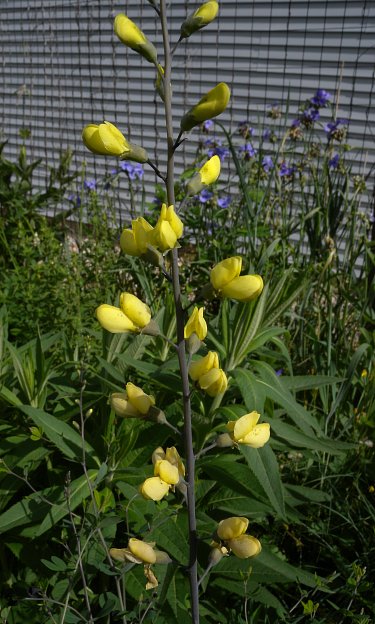
The leaflet bases are wedge-shaped (cuneate), while their tips are more or less rounded. Young leaflets are medium green and glabrous, but with age they become bluish green or grayish green on their upper surface and whitened on their lower surface. A reticulated network of fine veins is visible on the whitened lower surface of older leaves. The petioles of lower to middle trifoliate leaves are 4-8 mm. long, while the upper trifoliate leaves are nearly sessile. The petioles are light green to gray, slender, and finely grooved above. The petiolules of the terminal leaflets are very short (about 1 mm. in length), while the lateral leaflets are almost sessile. The central stem terminates in a spike-like raceme of flowers about 1' long, while the upper lateral stems terminate in spike-like racemes of flowers about 4-8" long. These racemes are usually erect, although some of the lateral racemes may be ascending. The flowers are distributed somewhat loosely along these racemes, facing in all directions. The central stalks (rachises and peduncles) of these racemes are grayish green to gray, terete, glabrous, and usually glaucous. Each flower is about ¾" long, ½" tall, and ½" across, consisting of 5 yellow petals, a grayish green to gray short-tubular calyx, 10 inserted stamens, and a pistil.
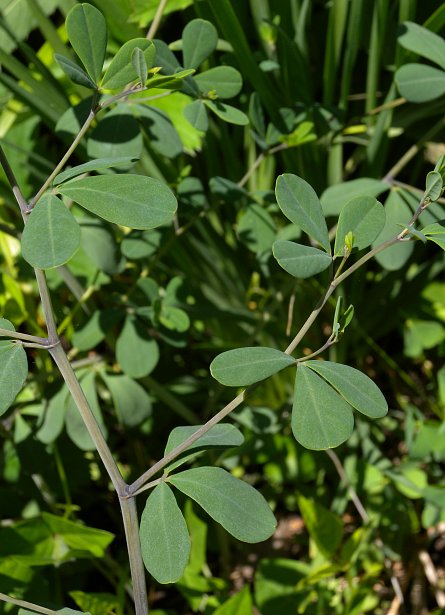
The petals are arranged in a typical pea-like floral structure, consisting of an upright banner and a forward-projecting pair of wings covering an interior keel. The lateral margins of the banner are curved away from the face of the flower, and the base of the banner may have a few small purplish splotches. The calyx is somewhat 2-lipped: its lower lip has 3 deltate-ovate teeth, while its upper lip is more or less convexly rounded. The slightly ascending pedicels of the flowers are 4-7 mm. long, slender, grayish green to gray, and glabrous. During the flower bud stage, there are also solitary floral bracts extending below the pedicels. These floral bracts are about the same length as the pedicels, linear-lanceolate in shape, and early-deciduous. The blooming period occurs from late spring to mid-summer, lasting about 3-4 weeks. There is no noticeable floral scent. Afterwards, fertile flowers are replaced by seedpods.
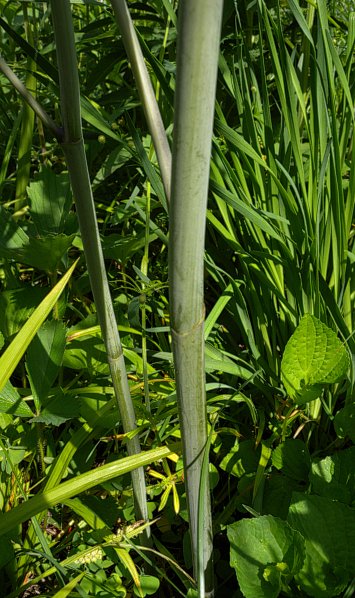
Mature seedpods are ¾" long, ½" across, obovoid-oblongoid in shape, somewhat inflated, and black; they are usually tapering in the front and abruptly rounded in the back. Each seedpod has a long slender stipe (about ½" long) that is straight and a short slender beak (about ¼" long) that is often somewhat curved. The walls of the mature pod are thin but firm; its usually contains a few seeds, otherwise it is hollow. The root system has thick rhizomes that are reddish brown and somewhat woody, from which more than one clonal plant can develop.
Cultivation: The preference is full to partial sun, mesic to dry conditions, and sandy loam, although heavier soils and the presence of gravel or rocky material is tolerated if drainage is good. Once danger of frost has passed, growth and development of an established plant is rapid. After the blooming period, this plant continues to grow, but at a much slower pace. This hybrid plant is adaptable to sunny situations, relatively long-lived, and easy to cultivate.
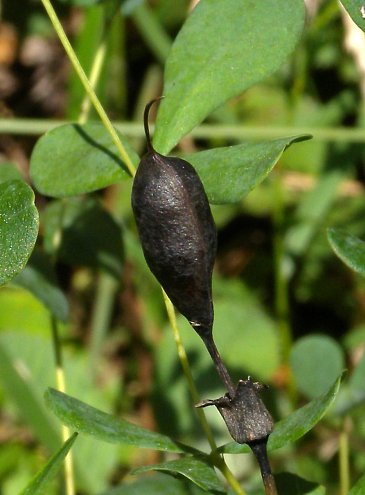
Range & Habitat: The native Deam's Wild Indigo is rare in Illinois, occurring as a natural hybrid in a single county (Kankakee County); see Distribution Map. It has also been found in a single county in NW Indiana, where it is also rare. In Illinois, Deam's Wild Indigo occurs in a sandy savanna and a sand prairie, where its two parent species, Baptisia alba macrophylla (White Wild Indigo) and Baptisia tinctoria (Yellow Wild Indigo), are also present. This hybrid species occurs in high quality natural areas that are usually sandy. Like other Baptisia spp. (Wild Indigo species), it probably benefits from occasional wildfires.
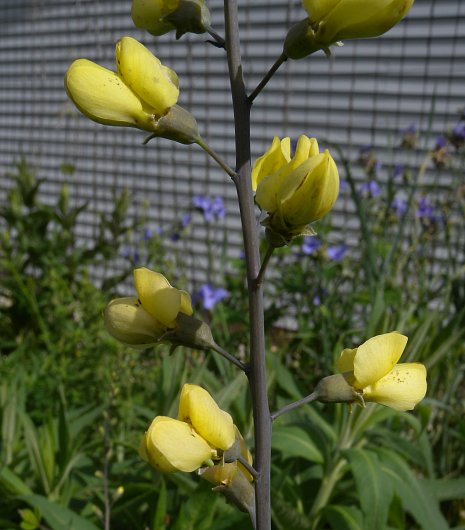
Faunal Associations: Various insects and their larvae feed on Baptisia spp. (Wild Indigo species). These species include the seed-eating larvae of a weevil (Apion rostrum), leaf-mining larvae of leaf beetles (Pachybrachis luridus, Pachybrachis trinotatus), seed-eating broad-headed bugs (Alydus conspersus, Alydus eurinus, Alydus pilosulus, Megalotomus quinquespinosus), leaf-mining larvae of a fly (Liriomyza baptisiae), larvae of the skippers Achalarus lyciades (Hoary Edge) and Erynnis baptisiae (Wild Indigo Duskywing), larvae of the butterfly Callophrys irus (Frosted Elfin), larvae of the Pyralid moths Pococera baptisiella (Wild Indigo Webworm Moth) and Sitochroa dasconalis (Pearly Indigo Borer Moth), larvae of the Tortricid moth Grapholita tristrigana (Three-lined Grapholita), and the oligophagous Neohydatothrips baptisiae (Wild Indigo Thrips); see Panzer et al. (2006), Clark et al. (2004), Bouseman et al. (2006), Bouseman & Sternburg (2001), Schaefer (1980), and Spencer & Steyskal (1986). Mammalian herbivores avoid consumption of Wild Indigo foliage because it is toxic to them.
Photographic Location: The wildflower garden of the webmaster in Urbana, Illinois.
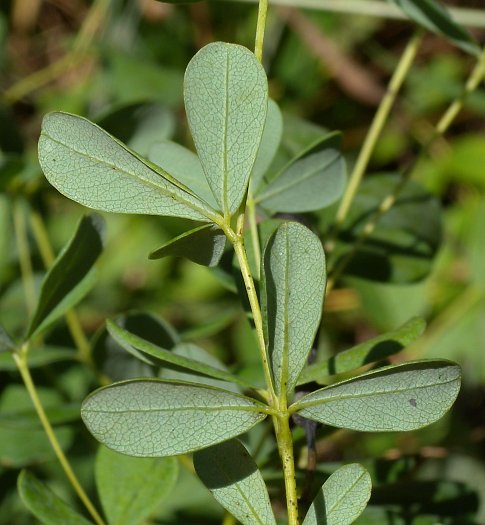
Comments: There is some disagreement among taxonomists regarding the classification of this hybrid plant. The ITIS and USDA, for example, consider Baptisia × deamii (Deam's Wild Indigo) to be a junior synonym of Baptisia × serenae (Serene Wild Indigo), which was originally described as a distinct species (Baptisia serenae) occurring along the SE coast of the United States. This view has been rejected because Baptisia × serenae is now widely considered a hybrid between Baptisia albescens (Spiked Wild Indigo) and Baptisia tinctoria (Yellow Wild Indigo), while Baptisia × deamii is considered a hybrid between Baptisia alba macrophylla (White Wild Indigo) and Baptisia tinctoria (Yellow Wild Indigo). This latter viewpoint is consistent with BONAP and Mohlenbrock (2014). Because both Baptisia alba macrophylla and Baptisia tinctoria have relatively broad ranges in the eastern United States and they are somewhat variable, specimens of Deam's Wild Indigo may exhibit significant variation in the size, shape, and hairiness of its leaves (if they are present, such hairs are restricted to the lower leaf surfaces). Deam's Wild Indigo can be readily distinguished from White Wild Indigo by its yellow flowers and usually smaller leaves, and it can be distinguished from Yellow Wild Indigo by its longer racemes (easily exceeding 4" in length), lack of branching on the lower central stem, and usually slightly larger leaves. Serene Wild Indigo, which is not found in Illinois, can be distinguished by the more cylindrical shape and reddish brown to purplish brown color of its mature seedpods.